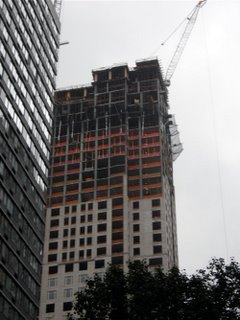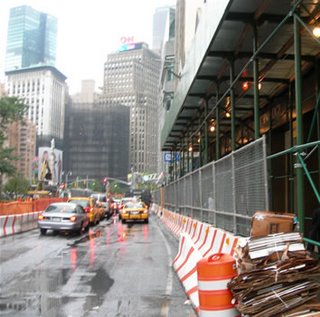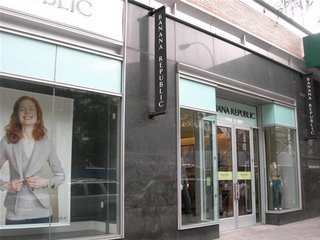Why NYC Housing Won't Crash
With all the bubble talk and speak of a housing market doomsday, I thought it would be warranted to take a step back, and see why NYC's housing market is likely NOT to crash compared to other highly speculative local markets such as Miami, Las Vegas & Phoenix.
First of all, housing must NOT be taken nationally! What is happening in one local market might be the complete opposite of what is happening in another local market! For example, as the housing market in Miami continues to see inventory rising and speculators rushing to flip their already purchased properties, the housing market on the outskirts of Philadelphia are seeing more demand and increasing prices.
See Jonathan Miller's post: Real Estate Brotherly Love: 2nd Quarter 2006 Market Report For Philadelphia, PA
On UrbanDigs, I try to focus on the NYC housing market because it is so different than almost all other markets across the country and the fundamentals powering it standalone. Given current macro-economic conditions that include rising interest rates, high energy prices, geo-political tensions, and inflation pressures where would one look to mark strength in housing? Well, people need a roof over their heads and rental prices nationwide are on the rise! That's a start. But what else?
Here are 5 reasons why I think the NYC housing market will correct but will NOT crash as the housing downturn continues into the next few years:
1. Population Growth - According to www.census.gov, NYC's estimated 2005 population is 8,143,197! Just to give you an idea of the size of this number, here are some population stats for other major cities.
New York - 8,143,197Miami - 2,376,014Chicago - 2,842,518Denver - 557,917Las Vegas - 545,147Boston - 559,034
NYC's population is still growing and buildable land is scarce! Housing will always be in demand and it will only be a matter of time until the rise in rental costs combine with a slowdown in housing put BUYING back in favor again! Read my post on "Rent-Hike Induced Housing Surge" for more info on this changing dynamic.
2. Rent Increases & Vacancy Rate Will Prevent A Housing Crash - Taking #1 a step further, NYC has experienced a declining vacany rate for the past 1-2 years or so mainly because of the housing boom and the conversions of rental buildings to condos to take advantage of market trends. The combination of high housing prices and lower inventory translated into a nightmare for renters; higher rental costs, less inventives offered, and little inventory to choose from!
Now, as the housing market continues to cool and inventory slowly rises more choices will be available to prospective purchasers feeding a buyer's market for years to come. Once prices start to come down as a result, I would expect more and more renters to convert to buyers to take advantage of the opportunity. This may not happen for another 1-2 years, but seems a very logical chain of events to predict given information at hand right now.
The skyrocketing rental market in NYC will be self-defeating and will contribute in providing a floor in the housing market downturn.
3. Lack of Speculators - Very interesting fundamental right here in that NYC is made up mostly of co-op's (aproximately 75% of NYC is co-op). As we all know, co-ops are private corporations that issue stock and a proprietary lease to the homeowner and generally have strict policies governing who is allowed to buy into the private corporation!
Since the other shareholders of the corporation have a vested interest in who becomes a stockholder, they can reject those who do not meet their financial guidelines or those who intend to use the property as a second home (pied-a-terre).
Speculative investors (a.k.a. flippers) do NOT like the co-op legal structure because it limits the marketability of their property and therefore goes againts their gameplan of buying and selling for a quick profit. In a nutshell, speculative investors go for condos! Since NYC is mostly co-op it is also protected against a large # of speculative investors which in turn will prevent a large # of apartments hitting the market at once as flippers run to 'cash out' before its too late!
On the other hand, a market like Miami is closer to 80% condo and allows a buyer to sell a pre-contruction unit even before they closed! That is speculator friendly and presents a very tough market to profit from when housing starts a downturn! Watch out Miami, San Diego, Las Vegas, and Phoenix!!
4. New Yorkers Earn $$$ - NYC is the financial capitol of this country and there is a ton of money floating around this city both to be made and to be spent! The median household income of a NYC family in 2004 was $50,731 as opposed to these other cities:
New York - $50,731Miami - $37,025Chicago - $40,656Denver - $43,777Las Vegas - $44,737
With the economy only now beginning to hint of a slowdown, NYC workers have had a very good run and incomes have risen over the past few years fueling the creation of a very large and suitable buyer pool. As the housing market cools and new workers save up for homeownership, I think all these dollars will be put to work via home ownership providing another floor to prevent any housing crash here in NYC!
The skinny: There is no lack of demand in NYC because people can't afford it! If anything, people are choosing to wait and save more to eventually buy down the road! In the end, there will be a very healthy and growing buyer pool waiting to put their money to work in NYC housing when an opportunity presents itself! NYC housing tends to have longer boom cycles and shorter bust cycles making it very hard to time the market perfectly.
5. Energy Prices & The Fed - I'm stretching a bit here on this one but I don't care. Its worth noting that living in NYC doesn't require a car! Everything is right at your footsteps here and if it's not, then your only a short subway/bus ride away; which is one of the main reasons why I love this city. The money you save on buying/leasing/financing car and the gas, insurance and maintenence fees are enough to rationalize moving to NYC! If you will save $800 a month by living in Queens but need a car to do so, then calculate what your spending every month on car expenses, gas, insurance and maintenence. I bet you it adds up to the difference in housing expenses saved! But, some people want a car and this argument won't apply to them. Fine. I'll stick to renting a car for $75 all in when I need to.
The there's the fed and their monetary policy. I reported last week on the fed's pause in raising interest rates for the first time in 2+ years. Good news for homeowners (especially HELOC owners) and potential buyers as mortgage rates dipped a bit in anticipation of this pause. The worst may not be over but its a start! With interest rates very close to their peak, money will still be historically cheap to borrow making homeownership possible for those who planned accordingly! While your monthly payments will be higher now than if you borrowed a few years ago, but hopefully the temporary decline in prices will be enough to offset the difference.
There you have it! My 5 reasons why NYC real estate will NOT crash. I do think a correction is already underway and that once the housing market makes that turn, it is very hard to stop it from proceeding down its chosen road. But you should all note that a correction in the housing market is a HEALTHY, NECESSARY STEP FOR LONGER TERM SUSTAINABLE GROWTH of housing. So, save up, get your credit perfect, and look for the opportunity that will both put a roof over your head and make you money!











